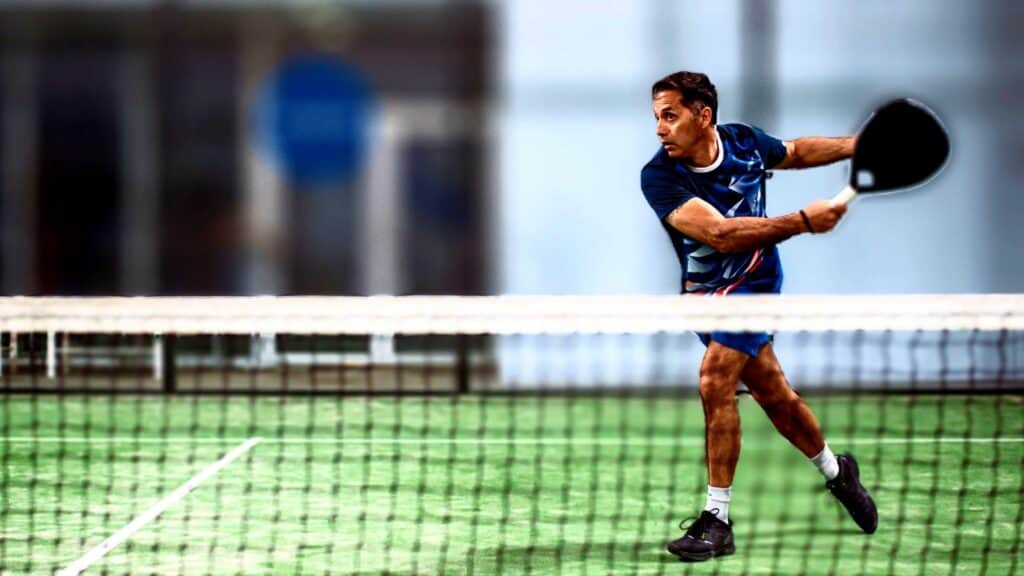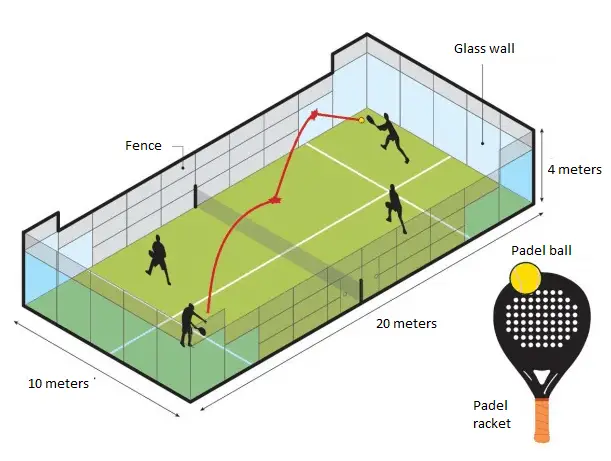I enjoy writing these articles for my readers, you guys. I don't accept payment for writing reviews, my opinion on products is my own, but if you find my recommendations helpful and you end up buying something through one of the links I may be able to receive a commission on that. More information
This relatively new tennis variant is going to conquer the world. It looks like a mix of squash and tennis and is also a racket sport. But what is padel tennis?
If you've ever been to Spain and play sports, you've probably heard of Padel tennis. It is actually one of the fastest growing sports in the world and in Spain it is huge!

It is estimated that padel is played by between six and 10 million Spaniards, compared to about 200.000 who actively play tennis.
Here Mart Huveneers explains exactly what padel is:
Padel tennis is growing every year. You've probably seen the runways. Its size is a third of a tennis court and the walls are glass.
The ball can bounce off any wall but can only hit the ground once before being returned. Similar to tennis.
The padel racket is short, without thread but with holes in the surface. You use a low-compression tennis ball and always serve underhand.
Padel is a sport that combines action with fun and social interaction. It's a great sport for players of all ages and abilities because it's both quick and easy to learn.
Most players learn the basics within the first half hour of playing so they can quickly enjoy the game.
Padel is not as dominated by strength, technique and services as it is in tennis and is therefore an ideal game for men, women and youth to compete together.
An important skill is match craft, as points are gained through strategy rather than pure strength and power.
What we discuss in this comprehensive post:
- 1 Have you tried padel tennis?
- 2 What are the dimensions of a padel court?
- 3 Rules of padel tennis
- 4 Padel vs tennis
- 5 Padel FAQs
- 5.1 Origin of Padel
- 5.2 Is Padel an Olympic sport?
- 5.3 Why is paddle tennis also played in winter?
- 5.4 Who invented Padel tennis?
- 5.5 What does a padel court look like?
- 5.6 How much does it cost to build a padel court?
- 5.7 Can you play Padel 1 vs 1?
- 5.8 Which countries play Padel?
- 5.9 What are the rules of Padel?
- 5.10 How long is a padel match?
- 6 Conclusion
Have you tried padel tennis?
Confession: I have not tried padel tennis myself. Of course I want to, but tennis has a special place in my heart and will be a priority.
But many of my tennis-playing friends love it. Especially some of those guys who were really good tennis players but never made it to the pro tour. This is a unique opportunity to advance in a new sport.
It certainly looks a lot of fun, especially since most points are won through tactics and clever play, not so much strength.
I also like the idea of not having to strain a racket. Stringing a racket can be a fun therapy, but stringing 3-5 rackets in a row can be quite tedious and boring.
Padel players do not have this problem.
Since you mainly use the slice shot and volley in padel, I thought it would have fewer cases of elbow injuries, but it actually seems to be quite common based on my research.
What are the dimensions of a padel court?

(image from tennisnerd.net)
The court is one third the size of a tennis court.
A padel court is 20 meters long and 10 meters wide with glass rear walls to a height of 3 metres, while the glass side walls terminate after 4 metres.
The walls could be made of glass or other solid material, even material such as concrete if that was easier for the construction of the field.
The rest of the field is closed with a metal mesh to a height of 4 meters.
In the middle of the playing field is a net that divides the field in two. It has a maximum height of 88 cm in the middle, increasing to 92 cm on both sides.
These squares are then separated in the middle by a line with a second line crossing it three meters from the back wall. This marks the service area.
De padel federation has prepared an extensive document with everything about the accommodation to guide starting clubs in setting up the right jobs.
Rules of padel tennis
Padel is a mix between tennis and squash. It is usually played in doubles on an enclosed court surrounded by glass walls and metal mesh.
The ball can bounce off any wall but can only hit the ground once before being knocked back. Points can be scored when the ball bounces twice in the opponent's court.
The game is quick and easy to learn, making it a fun and addictive sport to play.
Using a short, stringless racket with an elastic surface with holes and a low-compression tennis ball, the serve is taken underhand.
Strokes are played before or after the ball bounces off the surrounding glass walls, adding a unique dimension to the sport over conventional tennis.
How does the scoring in Padel work?
The scores and rules are very similar to tennis, with the main difference being that the serve in padel is underhand and balls can be played from the glass walls in the same way as in Squash.
The rules allow the use of the back and sidewalls, resulting in longer rallies than a conventional tennis match.
Points are won by strategy rather than strength and power and you win a point when the ball bounces twice in your opponent's half.
Padel vs tennis
If you'd like to try padel tennis, I'm sure there's a court somewhere not far from you. You will soon see more padel courts than tennis courts.
This breaks my heart a bit for tennis, but of course it's good that people play sports in every possible way.
Let's look at some pros and cons of padel vs tennis:
+ It is much easier to learn than tennis
+ You don't have to worry about strikers, hard services
+ Since there are always four players, it creates a social element
+ A lane is smaller, so you can fit more lanes in a smaller space
– Tennis is arguably more varied as you can overpower opponents, play a slice and dice game or anything in between.
– You only need two players to play tennis, but you can also play doubles, so more options.
– Tennis has a rich history as a sport.
Padel is clearly huge in Spain and played much more than tennis. It is also much easier than tennis and is truly a sport for all ages and sizes.
It doesn't take long to learn Padel and as a tennis player you will pick it up very quickly.
It requires much less skill and fitness than tennis while still being a very intense sport and easier on the joints as it doesn't require fast sprints and sudden stops.
It is also a great spectator sport as good games can have very long and fast matches.
Are there any other pros and cons of padel vs tennis that I missed?
Padel FAQs
Origin of Padel
The sport was invented in Acapulco, Mexico, by Enrique Corcuera in 1969. It is currently most popular in Latin American countries such as Argentina and Mexico, as well as Spain and Andora, although it is now rapidly spreading across Europe and other continents. .
Padel Pro Tour (PPT) was the professional padel circuit created in 2005 as a result of the agreement between a group of organizers of padel competitions and the Association of Professional Players of Pádel (AJPP) and the Spanish Women's Association of Pádel (AFEP).
Today the main padel circuit is the World Padel Tour (WPT), which started in Spain, but as of 2019, 6 of the 19 tournaments will be played outside of Spain.
In addition, there is the Padel World Championship what has become a major event and organized by the International Padel Federation.
Is Padel an Olympic sport?
According to the Padel Olympic Sport website, in order for a sport to be included in the Olympics, the International Olympic Committee states that it must be played in all continents, or else, it must be played in a certain number of countries.
With the rise of padel tennis around the world, the website suggests that Padel already fully meets these requirements, so maybe the sport isn't too far off to be recognized!
Padel is not yet an Olympic sport at the time of writing.
Why is paddle tennis also played in winter?
Paddle is the only racket sport played outside in cold weather thanks to the elevated courts enclosed by walls. The playing surface is heated so that snow and ice melt.
These aspects attract outdoor sports enthusiasts and fitness fans, who are excited about the opportunity to spend a cold winter's day outdoors. ball sport to practice.
Who invented Padel tennis?
The founder of padel, Enrique Corcuera, was a wealthy businessman. At home, he did not have enough space to set up a tennis court, so he invented a similar sport. He created a court measuring 10 by 20 meters and surrounded by 3-4 meter high walls.
What does a padel court look like?
Padel is played on a field of approximately 20m x 10m. The court has back walls and partial side walls made of stucco concrete which allows the Padel ball to bounce against it. Padel is played on indoor and outdoor courts.
How much does it cost to build a padel court?
To give a global idea; the price can be between 14.000 and 32.000 euros per padel court, depending on several factors such as the construction system based on wind load and place of installation.
Can you play Padel 1 vs 1?
Can you play single padel? Technically, you can play padel as a singles game, but it's not ideal. The padel game is designed for four players playing on a specially designed court that is 30% smaller than a tennis court.
Which countries play Padel?
Which countries play padel? Argentina, Australia, Austria, Belgium, Brazil, Canada, Chile, England, France, Germany, India, Italy, Mexico, Paraguay, Portugal, Spain, Switzerland, United States, Uruguay, Finland, United Arab Emirates, UK and Ireland .
What are the rules of Padel?
In Padel, the game begins with an underhand serve from the right service court in the opponent's court, diagonally opposite tennis. The server must bounce the ball once before hitting it and the ball must be hit below the hip. The service must end up in the opponent's service box.
How long is a padel match?
There can be a pro set of 8 games or the best of 3 in a standard set of six games. Breaks of 60 seconds when switching sides, 10 minutes between 2nd and 3rd set and 15 seconds between points are allowed.
Conclusion
I find padel tennis or 'padel' as it is more commonly called a great new addition to racket sports. It's easier to learn than tennis and you don't need to be as fit as the court is smaller.
You don't have to choose one sport over the other, but of course you can play and excel at both.


